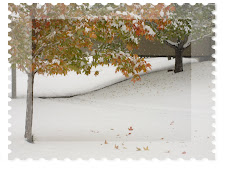Homemade Croissants... ATK/Cook' s Illustrated version... Memories of Paris. Freshly baked croissants in bakeries everywhere. Some filled with chocolate, some plain... but all of them flaky with a buttery goodness. Though it's been a few years since visiting Paris, I've kept many a memory of the times my husband and I would have breakfast together, stopping at a local bakery and ordering a delicious breakfast treat to go along with a cup of espresso. It seemed croissants were always available in the early morning hours....and you could smell the butter in the air as you entered the bakery shop.
Croissants. I've always wanted to make croissants... but could it ever be doable... you know, to make at home? And I mean the real croissants. The ones that are airy, flaky and buttery.... with a delicate crisp shattering outside "crust". Not the somewhat flaky pie crust/crescent type... where the butter sort of combines with the flour and has no layers. Those are good too, ... but I wanted the croissants to be like those in Paris.
I have to admit I've tried making croissants before... quite a few years ago. And as much as I wanted them to have been a success back then, well... they really weren't. And truth be told, I tried making croissants a few more times after that... with different recipes... until I gave up. Somehow, I felt I would never be able to get the dough to bake up like a real croissant.... like those in Paris. So I stopped trying to bake the "perfect" croissant. Figured the home cook can't... just don't have the right laminating machine, the right oven, etc. But recently, I decided to try again... after all these years. And this time... from a recipe by the folks at Cook's Illustrated.
I've always had great success with Cook's Illustrated/Cook's Country/America's Test Kitchen's recipes. Many of their recipes are personal favorites. So when I came across their croissant recipe video, I felt I could try making croissants again. I mean, they sure made it look simple! But before trying out the recipe, I made sure to have the right ingredients.... which meant european-style butter(less water and a bit higher fat%) and King Arthur's flour(has a bit higher protein%). I hardly ever buy european-style butter, but in this case, I was willing to buy it. I wanted my croissants to come out... without blaming myself that I didn't follow the recipe exactly. The butter was the only new ingredient I had to buy... because for the past few years, I've been using King Arthur flour for all my baking... so the flour wasn't an issue.
In any case, I basically followed their recipe without any changes of mine (well, except as noted in the last tip). The result was unbelievably amazing. You truly can make croissants at home! They were just what I had been wanting to make all these years... and I wouldn't change a thing about them. Even the butter was well worth the investment... you can actually taste the difference. And you know what?... the croissants weren't really that difficult to make.
Ok, I have to admit it might not be an easy recipe... especially for a beginner. And I must mention, since trying out my very first croissant recipe years ago, I've had plenty of experience with laminated dough(or puff pastry).... so I didn't attempt this recipe without knowing the basics. Over the years, I've learned through trials and errors, that a laminated dough must be kept cold at all times... otherwise, the dough won't have those distinct layers.... you'll just get a buttery dough. And since croissants are similar to puff pastry, I wasn't going into something foreign. The only difference in making a croissant dough is that you add yeast and milk.
This recipe is what a croissant is all about... I don't think I''ll be trying another recipe. For me it was a winner, and will definitely be making again. By the way, did you know the croissants were first invented in Austria?... at least that's what they say. Could have very well been. I wouldn't know. However, I do know the Austrians make amazing desserts... as do the French. But regardless who invented the croissant... this recipe is worth making. Just give yourself some time, don't rush and be as precise as possible... oh, and enjoy your hard work:). They're totally worth it. Hope you enjoy...
Update: I much prefer to bake ALL the croissants when freshly made and freezing them baked... rather than freezing the unbaked rolled croissants and then defrosting to rise and bake later.... the wait is too long, and they never seem to rise as high as the original.
Note: Though it looks like the longest of posts, the process isn't really that long... just lots of waiting in between folding, refrigerating and rising.
Tips:
- It really helps being precise... use a ruler to measure. Oh, and read the recipe/watch the video a couple of times to understand the process before proceeding.
- Keep your butter cold at all times... when folding dough, if you notice the butter getting soft, refrigerate/freeze dough until it firms up.
- Work in a 70 deg F kitchen... ideally no hotter. A couple of degrees above won't matter much, but when the kitchen is too hot, the croissants will suffer.
- While folding and rolling, use a straight edge(I used the side of a large knife) to bring the dough to the proper measurements.
- Allow the croissants to rise in a 68-72 deg F... ideally no colder nor much hotter. If it's too cold, the yeast will take much longer to activate... and if it's too hot, the butter in the dough will melt.
- While Cook's Illustrated/ATK does not say to lightly cover croissants with aluminum paper half way through baking, I find it essential to do this. This way you don't have croissants that are burned/overly browned.... and at the same time have the insides cooked through.
You will need:
from Cook's Illustrated(Jan/Feb 2012 issue), or the ATK's video clip(not sure how long this link will be valid), or Food. com
Dough:
3 tablespoons unsalted butter
1 3/4 cups whole milk
4 teaspoons instant or rapid-rise yeast
4 1/4 cups (21 1/4 ounces) all-purpose flour ( King Arthur is preferred, what I used)
1/4 cup (1 3/4 ounces) sugar
2 teaspoons kosher salt
Butter Block:
12 oz (24 tablespoons) unsalted European-style-butter, very cold (I used Plugra, recommended)
Egg Wash:
1 large egg
1 teaspoon cold water
pinch of salt
Directions:
DOUGH:
1. Over low heat, melt the 3 tablespoons butter in a medium saucepan. Remove pan from heat and immediately stir in milk (the temperature should be lower than 90 degrees F ).
2. Whisk in yeast and transfer milk mixture to bowl of a stand mixer.
3. Add the flour, sugar, and salt to the bowl with milk mixture. Using dough hook, knead on low speed until a cohesive dough forms... which should take about 2 to 3 minutes.
4. Increase mixer speed to medium-low and knead for 1 more minute.
5. Remove bowl from mixer and cover with plastic wrap.
6. Let dough rest at room temperature 30 minutes.
7. Transfer dough to parchment paper–lined baking sheet(I just placed a parchment paper on the counter and then placed the dough on the parchment paper)
8. Shape(using your fingertips) into 10 x 7-inch rectangle about 1 inch thick.
9. Wrap dough tightly with plastic and refrigerate for 2 hours.
BUTTER BLOCK:
1. While the dough chills, fold a 24-inch length of parchment paper in half to make a 12-inch rectangle.
2. Fold over the 3 open sides of the rectangle to form an 8-inch square with enclosed sides.
3. Crease folds firmly. Set aside.
4. Cut and place 24 tablespoons (12 oz) very cold butter directly on counter (or leave on butter paper) and beat with rolling pin for about 60 seconds (or so) until butter is just pliable but not warm. You can then fold butter on itself using bench scraper, but I didn't... I sort of cut a few pieces of butter and added them to the sides to make the corners.
5. Beat butter into a rough 6-inch square...
6. Unfold parchment envelope you set aside earlier. Using bench scraper(or butter paper), transfer butter to center of the parchment paper, refolding at creases to enclose.
7. Turn packet over, with flaps underneath, and using a rolling pin on top of the parchment paper, gently roll until butter fills the parchment square. Make sure you have an even thickness.
8. Refrigerate butter packet at least 45 minutes.... or longer.
LAMINATE:
Before making the laminate dough you will need to transfer the dough from the above DOUGH directions, step 8,... and place in the freezer for 30 minutes.
1. After 30 minutes in the freezer, transfer dough to lightly floured counter and roll into 17 x 8-inch rectangle with the long side parallel to edge of counter.
2. Unwrap butter packet and place the butter in center of dough.
3. Fold both sides of dough over butter so they meet in center. Press seam together with fingertips.
4. With rolling pin, press firmly on each open end of packet( top and bottom) to seal edges.
5. Roll out lengthwise into a 24 x 8-inch rectangle. Fold into thirds like a business letter ... so you get an 8-inch square.
6. Turn dough 90 degrees counterclockwise. Roll the dough out lengthwise again into 24 x 8-inch rectangle and fold into thirds.... like a business letter.
7. Place dough on a parchment paper (or cookie sheet), and wrap it tightly with plastic.
8. Return dough to freezer for 30 minutes.
Repeat folding after 30 minute freezer time:
1. Transfer dough from freezer to a lightly floured counter ... so that top flap opens on right.
2. Roll out dough lengthwise into 24 x 8-inch rectangle and fold into thirds.
3. Place dough on sheet, wrap tightly with plastic, and refrigerate for 2 hours or up to 24 hours. I left mine overnight.
SHAPE:
Before shaping you will need to remove the laminated dough from the fridge after it's been in the fridge for the 2-24 required hours.... and place in the freezer for 30 minutes.
1. After the dough has been in the freezer for 30 minutes, transfer it to a lightly floured counter and roll into 18 x 16-inch rectangle with long side of rectangle parallel to edge of counter.
2. Fold upper half of dough over lower half.
3. Using ruler, mark dough at 3-inch intervals along bottom edge with bench scraper (you should have 5 marks).
4. Move ruler to top edge of dough, measure in 1 1/2 inches from left, then use this mark to measure out 3-inch intervals (you should have 6 marks).
5. Starting at lower left corner, use sharp pizza wheel or knife to cut dough from mark to mark. You will have 12 triangles and 5 diamonds; discard scraps.... place scraps(next to each other) in a small tart pan to rise.
6. Unfold diamonds and cut into 10 triangles (making 22 equal-size triangles in total).
7. Position 1 triangle on counter. (Keep remaining triangles covered with plastic.)
8. Cut 1/2-inch slit in center of short side of triangle. Grasp triangle by 2 corners on either side of slit and stretch gently, then stretch bottom point, again gently.
9. Place triangle on counter so point is facing you. Fold down both sides of slit. Roll top of triangle partway toward point. Gently grasp point with 1 hand and stretch again. Resume rolling, tucking point underneath.
10. Curve ends gently toward each other to create crescent. Repeat with remaining triangles.
11. Place 9 shaped croissants on a parchment lined sheet (or 12 croissants on 2 parchment-lined sheets)... at least 2 1/2 inches apart.
12. Lightly wrap with plastic. Let stand at room temperature( 70 degrees F is ideal) until nearly doubled in size, 2 1/2 to 3 hours.
( The rest of the shaped croissants can be refrigerated for up to 18 hours. Remove from refrigerator to rise and add at least 30 minutes to rising time.... I personally haven't yet tried this.
Or you can freeze the rest of the shaped croissants (what I ended up doing).... see Make Ahead Note at the bottom of this post. )
13. After croissants have been rising for about 2 1/2 hours(or until croissants have almost doubled)...
- adjust oven rack to be in the middle... if making only 9 croissants and using 1 sheet.
- adjust oven racks to upper-middle and lower-middle positions... if making 12 croissants and using 2 sheets.
- heat oven to 425 degrees F.
14. In small bowl, whisk together egg, water, and pinch salt.
15. Brush croissants with egg wash. Place croissants in hot oven and reduce temperature to 400 degrees F.
16. Bake for 12 minutes, then switch and rotate baking sheets if making 12 croissants. If making only 9 you don't have to worry about rotating pans.
17. After about 12 minutes baking time, loosely cover croissants with aluminum paper and continue to bake until deep golden brown, 8 to 12 minutes longer. My total baking time was close to 20 minutes. Do watch so as not to burn.
Note: Covering the croissants with aluminum paper was my idea to keep the croissants from not burning on the outside, and yet still cooking completely inside.... you can skip it if you like, but the croissants have a tendency to burn rather quickly .
18. Transfer croissants to wire rack and cool about 15 minutes. Serve warm or at room temperature.
TO MAKE AHEAD: see step 12 above.
1. After shaping, place 10 croissants( or the remainder if you've baked only 9) 1 inch apart on parchment-lined sheet.
2. Wrap with plastic and freeze until solid, about 2 hours.
3. Transfer to zipper-lock bag and freeze for up to 2 months.
4. Bake frozen croissants as directed from step 8, increasing rising time by to 2 hours, or as needed to double in size.
















































